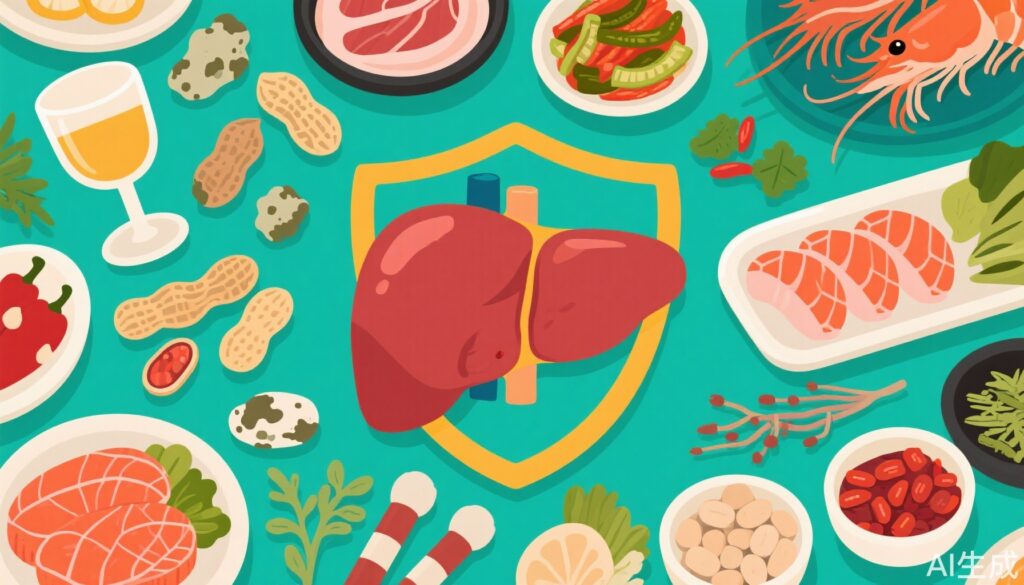Introduction: The Liver’s Vital Role and Why Its Health Matters
The liver is an essential organ often described as the body’s “chemical factory.” It performs critical functions including detoxification, metabolism of nutrients and drugs, and energy storage. As adults juggle work stress, late nights, alcohol, and convenience foods, our liver faces mounting challenges. Although often overlooked, liver health plays a foundational role in our overall well-being.
This article examines five common yet potentially harmful foods that can harm the liver and offers science-backed tips on how to maintain a healthy liver through lifestyle changes.
1. Alcohol: The Leading Liver Toxin
Alcohol is universally recognized as one of the most significant threats to liver health. The World Health Organization classifies alcohol as a Group 1 carcinogen, meaning it has a confirmed link to cancer development, including liver cancer (hepatocellular carcinoma). Chronic and excessive alcohol consumption can lead to fat accumulation in the liver (alcoholic fatty liver), inflammation (alcoholic hepatitis), fibrosis, cirrhosis, and ultimately, liver failure.
The Chinese Nutrition Society recommends an alcohol intake limit of no more than 15 grams per day for adults, roughly equivalent to one standard drink. Yet, many people consume far more regularly, unknowingly risking their liver health. Importantly, alcohol-induced liver damage is preventable and potentially reversible with abstinence at early stages.
2. Moldy Foods and Aflatoxins: Hidden Liver Poisons
Moldy foods, such as peanuts and corn, can harbor toxic fungal metabolites called mycotoxins. Among these, aflatoxin B1 is the most potent chemical carcinogen found in food, recognized by the International Agency for Research on Cancer (IARC) as a Group 1 carcinogen. Aflatoxin exposure causes DNA damage in liver cells, leading to mutations that increase liver cancer risk.
Consuming visibly moldy or improperly stored foods increases aflatoxin exposure unknowingly. Foods like moldy nuts, grains, and spices should never be consumed. Proper food storage, dryness, and quality control reduce this risk.
3. Raw or Undercooked Seafood: Risk of Viral and Parasitic Liver Infections
Raw or undercooked seafood, including shellfish and freshwater fish, poses a distinct risk for liver health due to possible contamination by hepatitis A virus and liver flukes like Clonorchis sinensis (Chinese liver fluke). Hepatitis A causes acute liver inflammation typically through fecal-oral transmission via contaminated food.
Liver fluke infections are common in regions where raw freshwater fish or fermented shrimp dishes are popular. The parasite lodges in bile ducts, causing chronic inflammation, bile duct obstruction, fibrosis, and increases the risk of cholangiocarcinoma (bile duct cancer). Guangdong province in China shows notably high infection rates tied to traditional food practices.
Avoiding raw seafood or ensuring thorough cooking is key to minimizing these infections.
4. Pickled and Fermented Foods: Potential Carcinogens and Liver Burden
Pickled and fermented vegetables, widely consumed across many cultures, can contain nitrosamines formed during the pickling process. Nitrosamines are carcinogenic substances that, with long-term consumption, can damage liver cells.
Epidemiological studies in areas with high liver cancer incidence have found positive correlations between frequent intake of these foods and liver cancer risk. In some regions, over 60% of pickled vegetables tested positive for nitrosamines.
Reducing consumption of traditional pickled products, choosing fresh or less processed vegetables, and maintaining a balanced diet can lower exposure to these harmful compounds.
5. Traditional Herbal Medicines: Risks of Toxic Components
The adage “every medicine has its poison” holds true for many traditional Chinese herbal medicines, whose complex mixtures include toxic substances that can cause liver injury. Drug-induced liver injury (DILI) related to herbal remedies is a significant clinical problem.
Examples include:
– Cinnabar (mercury sulfide), which can accumulate and cause heavy metal toxicity in the liver.
– Polygonum multiflorum (He Shou Wu), which contains anthraquinones leading to hepatotoxicity.
– Tripterygium wilfordii (Thunder God Vine), whose diterpenoids generate reactive oxygen species, damaging liver cells.
Excessive or inappropriate use of these herbs can raise serum liver enzymes and lead to acute or chronic liver damage. Always consult healthcare professionals before using herbal treatments.
Protecting Your Liver: Practical Lifestyle Habits
While avoiding harmful foods is crucial, proactive habits can further support liver health:
1. Avoid Sleep Deprivation: Although direct evidence linking sleep loss to liver damage is limited, irregular sleep disrupts circadian rhythms and hormonal balance, indirectly affecting liver metabolism. Studies indicate less than six hours of sleep increases the risk of non-alcoholic fatty liver disease (NAFLD). Target seven to eight hours of restful nightly sleep.
2. Exercise Regularly and Maintain Healthy Weight: Physical activity reduces liver fat accumulation, improves insulin sensitivity, and enhances blood flow, increasing liver oxygenation. Adults should aim for at least 150 minutes of moderate aerobic exercise weekly, supplemented with resistance training to sustain a healthy body mass index between 18.5 and 23.9.
3. Manage Stress and Anxiety: Chronic psychological stress adversely affects liver function and can promote fatty liver development. Stress reduction techniques such as meditation, yoga, and music therapy help maintain both mental and liver health.
4. Use Medications Responsibly: The liver metabolizes most drugs, so improper use or polypharmacy increases the risk of liver injury. Avoid self-medicating, respect prescribed doses, and consult physicians before combining supplements or medications.
5. Regular Health Checkups: Early detection of liver dysfunction is vital. Annual screening including liver function tests, hepatitis serology, and abdominal ultrasound is recommended, especially for individuals with risk factors like family history, obesity, or alcohol use.
Evaluating Liver Health Products: Are They Worth It?
The market offers numerous products claiming liver protection—”liver health supplements,” herbal teas, and pills often featuring milk thistle (silymarin), ginseng, or turmeric extracts.
– Liver Support Pills often contain plant extracts like milk thistle, believed to have antioxidant properties. Evidence suggests some improvement in liver enzymes, but definitive clinical benefits in healthy individuals or for curing liver diseases remain inconclusive.
– Liver Detox Teas use herbs with traditional claims for detoxification, yet scientific validation is lacking. Unregulated ingredients pose risks of contamination or side effects.
– Nutrition Supplements providing vitamins, amino acids, or minerals may support liver metabolism but generally are unnecessary for those with balanced diets. There’s also potential for harmful ingredients or poor quality control in some products.
Overall, these products cannot replace healthy lifestyle habits or medical treatments. Seek medical advice before incorporating such supplements.
Case Vignette: John’s Journey to Liver Health
John, a 45-year-old software engineer, enjoyed social drinking and frequently consumed pickled snacks and raw oysters. After experiencing fatigue and mild jaundice, he was diagnosed with early-stage fatty liver disease. His doctor advised reducing alcohol intake, eliminating raw seafood, and adopting a healthier lifestyle. John committed to exercising twice a week, improving sleep habits, and avoiding herbal supplements without medical guidance. Over six months, his liver function tests improved significantly, and he remained committed to liver-friendly living.
Conclusion: Prioritize Your Liver with Knowledge and Healthy Choices
Liver health is deeply influenced by what we eat, drink, and how we live. Five commonly consumed or encountered items—alcohol, moldy foods containing aflatoxins, raw seafood, pickled foods, and some traditional herbal medicines—pose risks to liver function that are often underappreciated.
Combining avoidance of these harmful exposures with physical activity, good sleep, stress management, cautious medication use, and regular medical checkups can protect and preserve liver health. Be skeptical of over-the-counter liver supplements unless recommended by healthcare professionals.
Remember, a healthy liver supports every aspect of your metabolism and wellbeing—treat it with the respect it deserves.
References
[1] Mega A, Marzi L, Kob M, Piccin A, Floreani A. Food and Nutrition in the Pathogenesis of Liver Damage. Nutrients. 2021 Apr 16;13(4):1326. doi: 10.3390/nu13041326.
[2] Yang Y, Zhang D, Feng N, et al. Increased intake of vegetables, but not fruit, reduces risk for hepatocellular carcinoma: A meta-analysis. Gastroenterology. 2014;147(5):1031–1042.
[3] Bravi F, Bosetti C, Tavani A, Gallus S, La Vecchia C. Coffee reduces risk for hepatocellular carcinoma: an updated meta-analysis. Clin Gastroenterol Hepatol. 2013 Nov;11(11):1413-21.
[4] Watling CZ, Wojt A, Florio AA, et al. Fiber and whole grain intakes in relation to liver cancer risk: An analysis in 2 prospective cohorts. Hepatology. 2024 Sep;80(3):552-565.
[5] World Health Organization, International Agency for Research on Cancer. Alcohol consumption and ethyl carbamate. IARC Monogr Eval Carcinog Risks Hum. 2010;96:3-138.
[6] Hernández Santiago K, López-López AL, Sánchez-Muñoz F, et al. Sleep deprivation induces oxidative stress in the liver and pancreas in rats. Heliyon. 2021;7(3):e06466.
[7] Imaizumi H, Takahashi A, Tanji N, et al. Association between Sleep Duration and Non-Alcoholic Fatty Liver Disease. Obes Facts. 2015;8(4):234-242.
[8] NIH. Milk Thistle. https://www.nccih.nih.gov/health/milk-thistle
(This article was crafted respecting scientific rigor and accessibility to general and professional audiences.)


